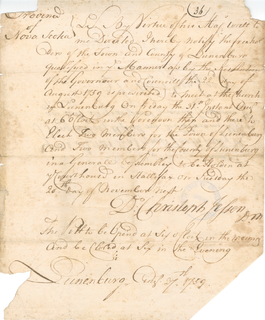Sutherland was a constituency of the House of Commons of the Parliament of Great Britain from 1708 to 1801 and of the Parliament of the United Kingdom from 1801 to 1918. It represented essentially the traditional county of Sutherland, electing one Member of Parliament (MP). The county town of Dornoch, however, was represented as a component of the Tain Burghs constituency, from 1708 to 1832, and of the Wick Burghs constituency, from 1832 to 1918.

Harold John Tennant PC, often known as Jack Tennant, was a Scottish Liberal politician. He served as Secretary for Scotland under his brother-in-law H. H. Asquith between July and December 1916.
Haddingtonshire was a county constituency represented in the House of Commons of the Parliament of the United Kingdom from 1708-1918.
Wick Burghs, sometimes known as Northern Burghs, was a constituency of the House of Commons of the Parliament of the United Kingdom from 1832 to 1918. It elected one Member of Parliament (MP) by the first past the post voting system.
Kincardineshire was a constituency of the House of Commons of the Parliament of Great Britain from 1708 to 1801 and of the Parliament of the United Kingdom from 1801 to 1918. It was represented by one Member of Parliament (MP).
Wigtownshire, was a constituency of the House of Commons of the Parliament of Great Britain from 1708 to 1801 and of the Parliament of the United Kingdom from 1801 to 1918. It was represented by one Member of Parliament.
Stirlingshire was a county constituency of the House of Commons of the Parliament of Great Britain and later of the Parliament of the United Kingdom from 1708 until 1918. It elected one Member of Parliament (MP) by the first past the post voting system.

Warrington was a parliamentary constituency in the United Kingdom. From 1832 to 1983 it returned one Member of Parliament (MP) to the House of Commons of the Parliament of the United Kingdom.
The South Shields by-election, 1916 was a parliamentary by-election held for the House of Commons constituency of South Shields on 18 March 1916.
The Chesterton by-election, 1915 was a parliamentary by-election held for the House of Commons constituency of the Chesterton or Western Division of Cambridgeshire on 13 February 1915.
The Chesterton by-election, 1916 was a parliamentary by-election held for the House of Commons constituency of the Chesterton or Western Division of Cambridgeshire on 20 January 1916.
The Haddingtonshire by-election was a Parliamentary by-election. It returned one Member of Parliament to the House of Commons of the Parliament of the United Kingdom, elected by the first past the post voting system.

The Wandsworth by-election was a Parliamentary by-election. It returned one Member of Parliament to the House of Commons of the United Kingdom, elected by the first past the post voting system.
The Midlothian by-election was a Parliamentary by-election. It returned one Member of Parliament to the House of Commons of the United Kingdom, elected by the first past the post voting system.
The Chesterton by-election, 1917 was a parliamentary by-election held on 27 July 1917 for the House of Commons constituency of Chesterton also known as the Western Division of Cambridgeshire.
The Edinburgh South by-election, 1917 was a parliamentary by-election held for the House of Commons constituency of Edinburgh South in Scotland on 12 May 1917.
The Edinburgh South by-election, 1910 was a parliamentary by-election held for the House of Commons constituency of Edinburgh South in Scotland on 29 April 1910.
The Anglesey by-election, 1907 was a parliamentary by-election held for the House of Commons constituency of Anglesey in North Wales on 21 August 1907.
The Inverness-shire by-election, 1917 was a parliamentary by-election held for the House of Commons constituency of Inverness-shire in the Scottish Highlands on 2 January 1917.
The Derby by-election, 1886 was a parliamentary by-election held for the House of Commons constituency of Derby, the county town of Derbyshire on 9 February 1886.







